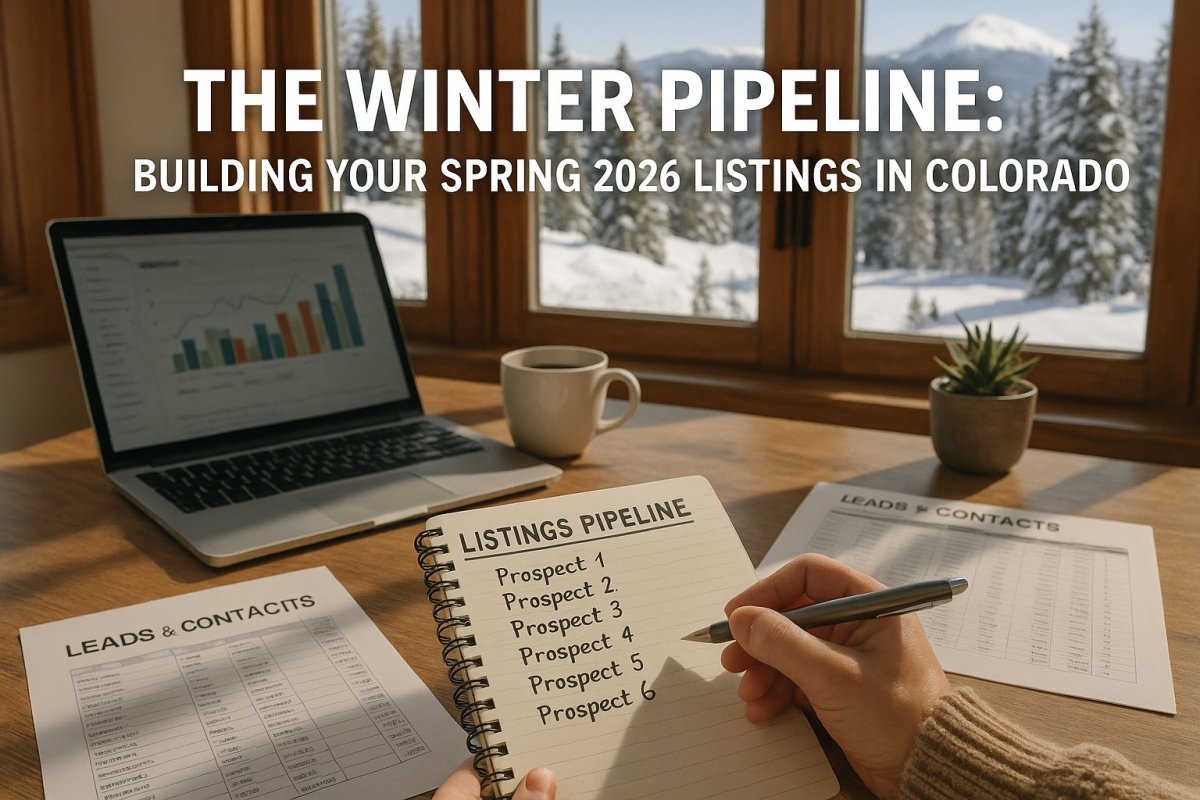Executive Summary: In Colorado, December–February isn’t a lull—it’s leverage. Seasonal listing patterns, life-event timing, and the practical limits of mortgage “lock-in” converge to create a quiet but highly actionable window for agents who want to dominate Spring 2026. This article quantifies the winter-to-spring surge, explains why post-holiday motivations (downsizing, inheritance, relocations, HELOC pressure) override interest-rate friction for a meaningful subset of owners, and shows how to use micro-market intelligence and predictive scoring to focus on the most likely sellers across Denver Metro, Colorado Springs, and Northern Colorado. You’ll leave with a month-by-month outreach plan, ready-to-use talking points, and a framework for converting winter conversations into signed listings that hit the MLS in March/April.
1) Why winter is the springboard: seasonality you can plan around
Colorado’s housing market follows a clear winter–spring rhythm. New listings and buyer showings ebb through late November and December, then begin building in January, typically accelerating into March and April. Days on market (DOM) compress in spring, and median prices often show a mild seasonal premium as household formation, school calendars, and relocation cycles funnel demand into the same months. If you want your sign in the yard in March, you need the listing agreement in January or February.
Seen through a pipeline lens, winter is not about closing volume—it’s about creating spring inventory. The agents who treat December–February as their “prep season” consistently hit the ground running when the thaw arrives. Those who wait for warmer weather scramble to find sellers who have already chosen someone else.
Seasonality at a glance (planning heuristics)
- New listings: Bottom late Dec; +50–100% jump from Dec → Jan in many Front Range sub-markets; a second surge into March/April.
- DOM: Longest in Dec/Jan; compresses noticeably by April as buyers re-enter and inventory gets absorbed.
- Spring premium: Even in “cooler” cycles, spring launch windows (mid-March through May) often show slightly stronger list-to-close ratios vs. late fall.
Implication: Treat winter like a build-phase project. Identify and educate likely sellers now so you can launch them into that spring demand curve, not after it.
2) The motivation curve: why post-holiday life events beat rate lock-in
The mortgage “lock-in” effect is real: owners sitting on 2–4% fixed rates are less inclined to move when prevailing rates are higher. But life doesn’t operate on rate charts. Every winter, a meaningful slice of owners face events that override financial inertia: inheritance, divorce, job relocation, retirement, accessibility needs, new children, or variable-rate debt pressure (notably HELOCs). These “life-event sellers” form the actionable core of your winter pipeline:
- Downsizers & right-sizers: Empty-nest owners reassess fit after the holidays, especially if stairs, maintenance, or winter costs bite. See our related playbook, "How to Find Trapped Equity Downsizers."
- Inheritance & estates: Out-of-state heirs frequently seek a fast, clean disposition starting in January. See "Why Out-of-State Heirs are Motivated Sellers" for positioning.
- Relocations: Corporate and military moves cluster in Q1. Colorado Springs PCS flows and Denver tech moves are winter prospects that aim for spring closings.
- HELOC squeeze: Owners with a low-rate first mortgage + variable HELOC now seeing payment spikes—financial pressure trumps lock-in. See our guide to the "HELOC Squeeze."
These households aren’t “waiting for 4% again.” They’re solving a problem. Your job is to surface them early, match your message to their motivation, and de-risk their path to market.
3) Colorado stock by mortgage status: who’s most likely to list in 2026?
At a statewide level, think in three buckets. Exact counts vary by source and date, but the framing holds:
| Segment | Colorado owners (approx.) | Primary triggers | Winter propensity | Rate sensitivity |
|---|---|---|---|---|
| Free-and-clear | ~30–32% of owners | Downsize, inheritance, relocation | Moderate (life-events) | Low (no financing friction) |
| Sub-4% mortgage | ~50–55% of with-mortgage owners | Strong life-events, HOA/insurance shocks | Low–Moderate | Low–Moderate (payment delta still big) |
| ≥4% mortgage | ~45–50% of with-mortgage owners | Move-up/move-down as rates ease | Moderate | High (first movers as rates drift lower) |
Prospecting signal: Free-and-clear + life-event markers; ≥4% cohort as rates drift toward ~6%; sub-4% only when non-rate triggers are strong.
4) Regional nuance along the Front Range
One “Colorado market” doesn’t exist. You’re working a chain of micro-markets from Colorado Springs to Denver to Greeley. The motivations, price bands, and seasonal elasticity vary—so should your outreach.
Denver Metro (seven-county)
- Profile: High equity concentration; many sub-4% notes; strong spring premium; micro-market splits (detached vs. condo/TH).
- Winter targets: Long-tenure downsizers in detached neighborhoods; relocating professionals; condo/TH owners facing rising dues/assessments.
- Messaging: “List into the spring window, not after it.” Emphasize total cost (HOA/insurance), not just P&I. See our guide on "Mastering Micro-Markets."
Colorado Springs (El Paso County)
- Profile: PCS/military flow; VA assumability can unlock buyer demand; price points below Denver; rising winter inventory but resilient spring absorption.
- Winter targets: PCS sellers; HELOC squeeze households; retirees with free-and-clear homes.
- Messaging: “Certainty + logistics.” Showcase VA-assumable angle where applicable; emphasize timeline control and bridge/rent-back options.
Northern Colorado (Fort Collins, Loveland, Greeley corridor)
- Profile: University/healthcare cycles; older owner share in select tracts; investor pockets; strong life-event throughput (inheritance, right-sizing).
- Winter targets: Out-of-state heirs; tired landlords; growing families in entry/mid bands.
- Messaging: Concierge handling for estates; equity release casework; buy-down math for move-ups.
5) Benchmarks table (planning ranges, not MLS quotes)
Use this as a planning scaffold for conversations and timelines. Always calibrate to current MLS in your target ZIPs.
| Region | Active listings (Dec–Feb) | Active listings (Mar–May) | Avg DOM (winter → spring) | Median price (winter → spring) | Free-and-clear share (est.) | Key winter seller types |
|---|---|---|---|---|---|---|
| Denver Metro | ~5–6k | ~7–9k | ~45–60 → ~25–35 | ~$540–560k → ~$570–590k | ~27–29% | Downsizers; relocations; condo/TH with rising dues |
| Colorado Springs | ~2.3–2.7k | ~3.0–3.3k | ~45–55 → ~30–40 | ~$440–460k → ~$460–480k | ~29–31% | PCS sellers; HELOC squeeze; retirees |
| Northern Colorado | ~1.6–2.0k | ~2.3–2.7k | ~50–60 → ~35–45 | ~$490–510k → ~$510–530k | ~30–33% | Heirs; tired landlords; growing families |
6) Case studies: three high-probability winter sellers
A) The Trapped Equity Downsizer (Littleton, detached)
Situation: 28-year tenure, two-story on a large lot, minimal updates in the last decade, mortgage nearly (or fully) paid off. Winter chores highlight fatigue and risk (ice, roof, furnace). Decision crystallizes after a holiday with adult children: cash out and move to single-level.
Approach: Lead with equity clarity and low-stress logistics. Offer a winter “Right-Size Review” (equity estimate + patio/ranch comps + net proceeds). Present a gentle timeline: prep in Feb, list mid-March, negotiate rent-back, close by May. Provide vendor bench (stager, organizer, mover). See our full guide: "How to Find Trapped Equity Downsizers."
B) The HELOC Squeeze (Highlands Ranch, remodeled 2022)
Situation: 3% first mortgage + $120k HELOC now at ~8% variable; monthly outflow up $600–$900 vs. 2022. Owner tried short-term rental to offset but it’s disruptive. They realize selling now preserves equity before delinquency risk.
Approach: Normalize the decision as smart, not shameful. Build a simple net proceeds worksheet. Position a spring sale as a “financial reset,” with options: rent for 6–12 months or buy smaller (possibly cash). Use concessions/buy-downs on their purchase to compress payment. See the full playbook: "The HELOC Squeeze."
C) The Out-of-State Heir (Fort Collins, 1970s estate)
Situation: Personal representative lives in California; property is vacant; house is dated but solid; probate permits sale; family wants a clean disposition.
Approach: Send a condolence + service letter. Offer full concierge: key exchange, contractor bids, clean-out, light updates, weekly photo updates. Present both options: “quick investor purchase” vs. “MLS in March for likely higher net.” See the full strategy: "Why Out-of-State Heirs are Motivated Sellers."
7) Scripts & frameworks that disarm winter objections
Objection: “We have a 2.9% mortgage; we can’t give that up.”
Response: “Many owners feel that way. The ones moving now aren’t doing it for the rate—they’re doing it because the home no longer fits or finances changed. If your reason to move is strong enough, we can compress the payment delta with credits/buy-downs—or avoid a new loan entirely if you downsize. Let’s look at your equity and options.” (Get more scripts in our "Locked-In Effect" playbook.)
Objection: “Isn’t winter a bad time to start? We’ll wait until May.”
Response: “Preparation in winter is how you win in spring. If you begin in May, you’ll list after the spring peak. Many of my spring sellers sign in January, prepare in February, and launch mid-March—right when buyer traffic accelerates.”
Objection: “We don’t have time to organize Dad’s house.”
Response: “We’ll handle it. I have trusted vendors for clean-out, donation, hauling, handyman work—plus weekly progress updates so you don’t have to travel. Your role is decision-making; we handle execution.”
8) Financial framing: compressing the payment delta
For rate-sensitive owners (≥4% cohorts, move-ups), show the math in a simple table. Compare: current payment vs. target home with seller credits and a 2-1 or permanent buydown. Include taxes, insurance, HOA. Many sellers overestimate the gap; reducing ambiguity unlocks action. Pair with lender partners who can rate-shop, model buydowns, and pre-underwrite quickly.
9) The 90-day winter action plan (Dec → Feb)
December — Foundation & soft touches
- Data pass: Pull a 12–24 month turnover map for your farm; tag ZIP+property-type cells with rising absorption or falling DOM.
- Target file: Build a 60–120 household list: long-tenure downsizers, out-of-state tax bills on inherited homes, owners with HOA/insurance stress, and ≥4% cohorts in elastic sub-markets.
- Warm touches: Holiday card + one-page “Winter→Spring Market Prep” tip-sheet. Offer a free Equity & Timing Review.
- Vendors: Pre-book a stager, photographer, handyman for quick February turnarounds.
January — Engagement & education
- 3-touch cadence: (1) New-Year email with hyper-local stats; (2) consult invitation call; (3) hand-addressed note to top 25 prospects.
- Seminar/webinar: “Selling in Spring 2026: Timing, Pricing, and Financing Tactics.” Co-host with a lender for buydown strategies.
- Collateral: Equity briefs (net proceeds bands); Rate-relief worksheets (6.4%, 6.1%, 5.9% scenarios); Micro-market one-pagers.
- Predictive focus: Use TimeToSell scores to prioritize: heirs → downsizers → HELOC squeeze → ≥4% trade-ups.
- Goal: 6–10 CMAs scheduled; 3–5 February listing agreements queued.
February — Conversion & prep
- Agreements: Present a calendar that lists launch target (mid-March), prep milestones, and rent-back/bridge options.
- Production: Photo, copy, staging, minor repairs; order preliminary title; line up “coming soon” compliant teasers.
- Fine-tune pricing: Price to the active buyer pool, not prior spring headlines; use concessions to target payment pain vs. across-the-board price cuts.
- Goal: All March listings photo-ready by Feb 28; April pipeline in second-position prep.
10) KPI dashboard to run weekly in winter
- ZIP-level new listings vs. pendings: balance inflection indicator.
- Median DOM by property type: early momentum in select micro-markets.
- List-to-close ratio trend: pricing power shifts.
- Mortgage app/refi ticks: demand & affordability signals.
- HOA/insurance bulletins: special assessments = seller triggers.
11) Compliance, care, and brand protection
Life-event outreach requires empathy and diligence. Keep language sensitive for estates/divorces. Document service scope for out-of-state heirs. Be transparent on investor-vs-MLS options. In short: be the professional who solves problems and preserves dignity.
12) Pulling it together: a repeatable winter playbook
- Define territory & signals: Denver Metro neighborhoods + Springs PCS tracts + NoCo inheritance corridors.
- Build a precise target list: Predictive scoring + tenure/equity + HOA/insurance stress + public-record changes.
- Install a January education engine: Seminar + micro-reports + one-to-one consults.
- Convert with certainty tools: Equity math, payment compression, list-then-buy flowcharts, rent-backs.
- Operationalize February: Production sprints and launch dates.
Turn winter into your competitive edge. The sellers who must move are already making decisions. Identify them, educate them, and be ready to launch in March. Activate your free TimeToSell.AI account and use your $100 lead voucher to surface high-probability sellers in your exact farm—so you enter Spring 2026 with listings queued, not questions.





